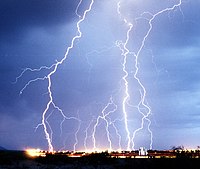
Photo from wikipedia
Context. Compensated-current systems are established in response to hot ion beams in terrestrial foreshock regions, around supernova remnants, and in other space and astrophysical plasmas. Aims. We study a non-resonant… Click to show full abstract
Context. Compensated-current systems are established in response to hot ion beams in terrestrial foreshock regions, around supernova remnants, and in other space and astrophysical plasmas. Aims. We study a non-resonant reactive instability of Alfven waves propagating quasi-parallel to the background magnetic field B0 in such systems. Methods. The instability is investigated analytically in the framework of kinetic theory applied to the hydrogen plasmas penetrated by hot proton beams. Results. The instability arises at parallel wavenumbers kz that are sufficiently large to demagnetize the beam ions, kzVTb/ωBi ≳ 1 (here VTb is the beam thermal speed along B0 and ωBi is the ion-cyclotron frequency). The Alfven mode is then made unstable by the imbalance of perturbed currents carried by the magnetized background electrons and partially demagnetized beam ions. The destabilizing effects of the beam temperature and the temperature dependence of the instability threshold and growth rate are demonstrated for the first time. The beam temperature, density, and bulk speed are all destabilizing and can be combined in a single destabilizing factor αb triggering the instability at αb > αbthr, where the threshold value varies in a narrow range 2.43 ≤ αbthr ≤ 4.87. New analytical expressions for the instability growth rate and its boundary in the parameter space are obtained and can be directly compared with observations. Two applications to terrestrial foreshocks and foreshocks around supernova remnants are briefly discussed. In particular, our results suggest that the ions reflected by the shocks around supernova remnants can drive stronger instability than the cosmic rays.
Journal Title: Astronomy and Astrophysics
Year Published: 2018
Link to full text (if available)
Share on Social Media: Sign Up to like & get
recommendations!